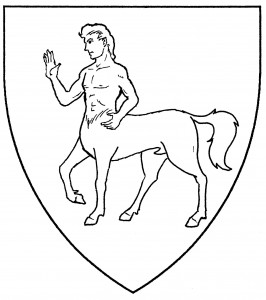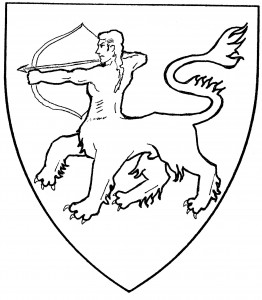The centaur is a monster from Greek myth, with the body and legs of a horse and the torso, arms and head of a human. Male and female centaurs are found in Society heraldry; blazons of posture (e.g., “passant”) refer to the equine portion, not the human.
Nearly all of the period heraldic examples of the centaur show it with a bow and arrow, as in the arms of Bardi, c.1550 [BSB Cod.Icon 278:81], or in the crest of Mackonele of the Yles, c.1601 [Bedingfeld 147]. Such cases may also be blazoned a “sagittary” or “sagittarius”. When blazoned “proper”, the centaur has a Caucasian human torso and a brown horse’s body.
A “leonine-centaur” (or, with a bow, a “leonine-sagittary”) has the body of a lion, instead of a horse; it’s found in the attributed arms of King Stephen of England, c.1097 [Dennys 119].
The illustrations show a centaur passant and a leonine-sagittary passant drawing a bow.
Chuluun the Scribe bears: Gules, two sagittaries salient addorsed Or.
Tatiana Aleksandrovna bears: Or, a female centaur passant within a bordure gules.
Piers of Malmesbury bears: Per pale gules and azure, in pale two leonine sagittaries passant argent.

